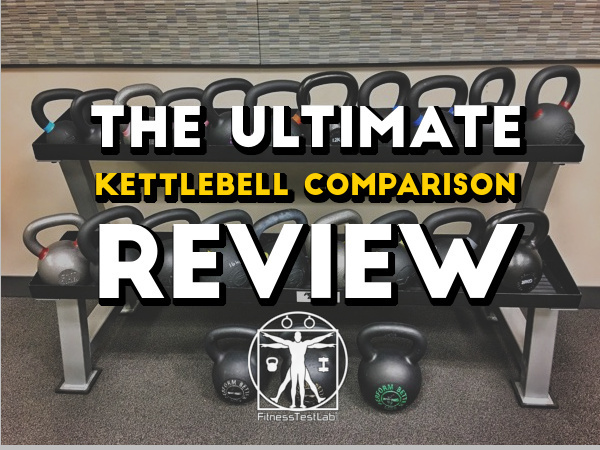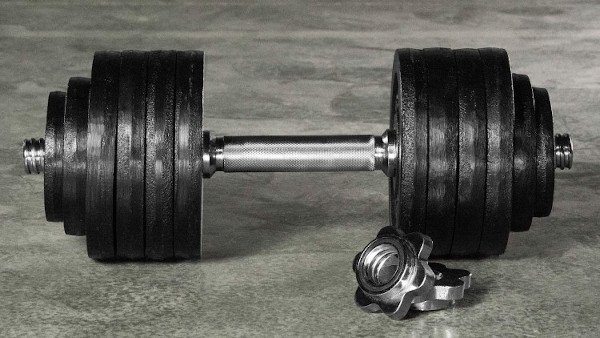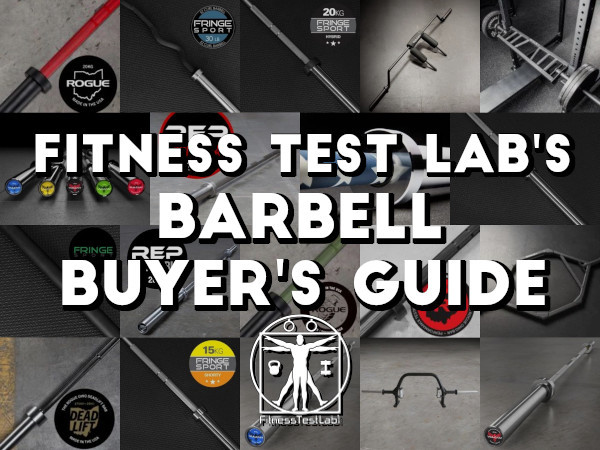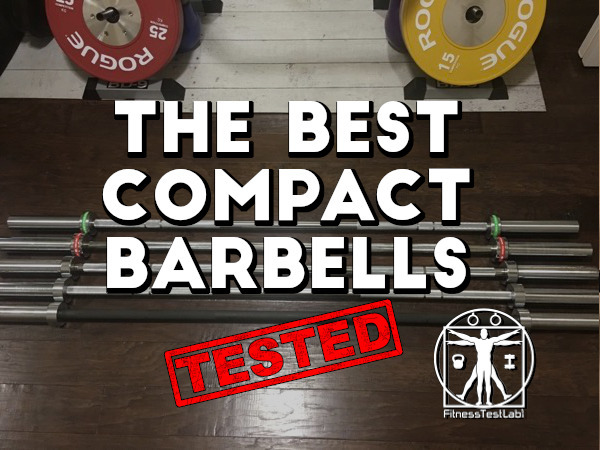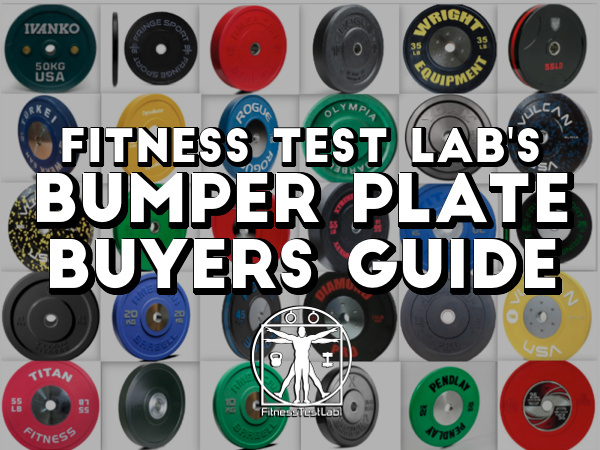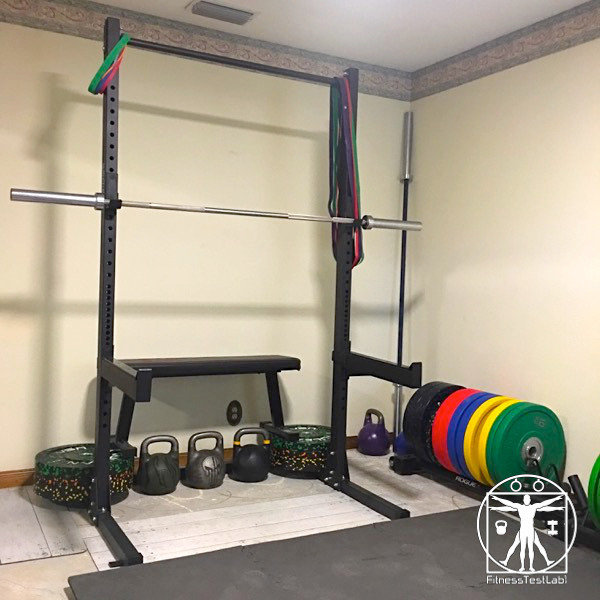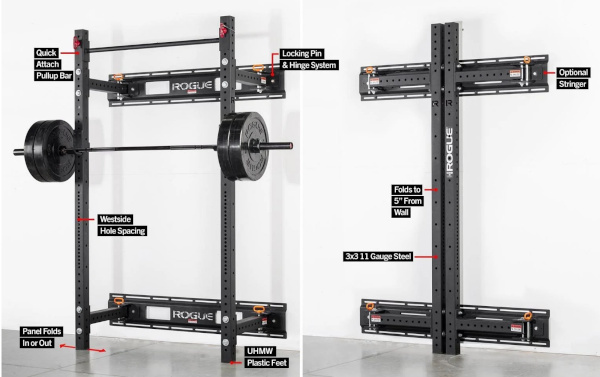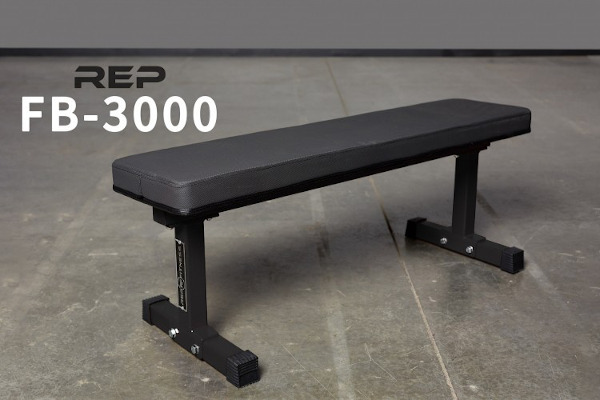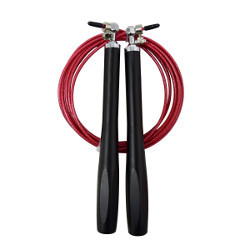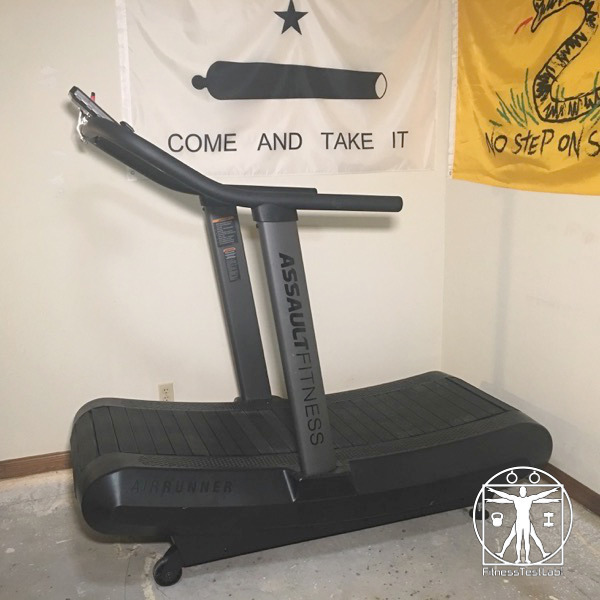Home Gym Essentials
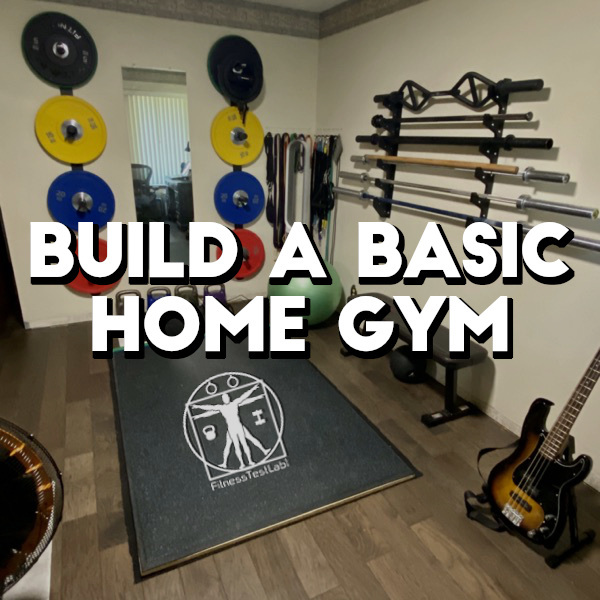
Good news everyone! You don’t need a room full of expensive equipment to achieve your fitness goals.
My aim with this article is to give you the information you need to build an efficent home gym that meets your specific goals, space constraints, and budget.
Build a basic home gym
The four most important factors to consider when building a home gym are:
- The space available to you for exercise
- The space available for storing your equipment
- Your interest in a particular style of training
- Your budget for equipment
Some would argue that budget is the most important factor, but I think not.
Having the money to buy a big fancy power rack won’t help if you have nowhere to set it up and use it. And, that power rack may just sit and collect dust if you’re not particularly interested in Powerlifting.
My goals are more practical – I want the minimum amount of equipment I need to stay healthy and fit, while offering enough variety to help me stay motivated to exercise.
To keep things simple, my recommendations center around the essentials for three main styles of exercise – Functional Training (CrossFit), Powerlifting, and Olympic weightlifting.

Basic home gym, bass guitar not strictly necessary
Quality versus price
The equipment you choose for your home gym will be the tools you use to shape your health and fitness for years to come. Like any good craftsman, you should carefully consider the quality of those tools when deciding what to buy.
My motto is “Buy Nice or Buy Twice”, since cheap gear inevitably needs replacement.
All of my recommendations are focused on value – the best combination of quality and price I can find for the benefit provided, regardless of brand name.
Home gym essentials
You can build a cost effective and practical home gym with some basic pieces of equipment and a little bit of smart shopping.
You don’t need everything I’ve listed below. I’m offering these recommendations with the understanding that you’ll pick the things from the list that best suit your needs.
However, if you have any questions by all means drop me a comment and I’ll do my best to guide you.
Kettlebells
If you have limited space to exercise and to store your equipment, kettlebells are a great option.
Kettlebells are easy to store, relatively inexpensive, and provide a time-saving way to work nearly every part of your body in a short period.
You can read my Ultimate Kettlebell Comparison Review that covers every major brand of cast iron kettlebell, but the top picks are:
- Kettlebell Kings Powder Coat kettlebell (full review) – best overall cast iron kettlebell
- Kettlebells USA Metrixx Elite Precision kettlebell (full review) – most durable cast iron kettlebell
- Rep Fitness Cast Iron Kettlebell (full review) – best value cast iron kettlebell
If you need workouts, I have several simple and free kettlebell workouts I’ve put together that can be done in 30 minutes or less.
If you prefer instructor-led workouts, I recommend the well designed programs put together by Kettlebell Kings via their Living.Fit online platform.
There’s also an entire sport dedicated to kettlebells, unsurprisingly called “kettlebell sport”. Kettlebell sport has many benefits and is suitable for both men and women.
The kettlebells used in kettlebell sport are made of steel instead of cast iron, and unlike cast iron kettlebells, “competition” kettlebells all conform to a single standard size.
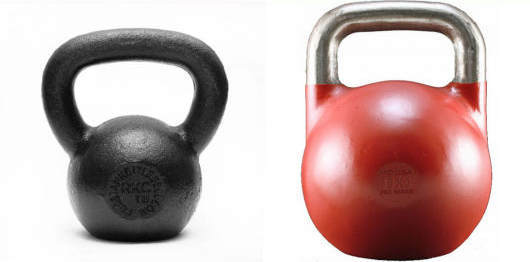
Kettelbell types – cast iron (left) vs steel competition (right)
The consistent size of competition kettlebells allows you to stay focused on your technique as you move up or down in weight rather than having to adjust to different sizes as you would with cast iron kettlebells.
Here are my top three recommendations for competition kettlebells:
- Kettlebell Kings Competition (full review)- designed specifically for high repetition exercise and used in many kettlebell sport events around the world
- Kettlebells USA Paradigm Pro Elite (full review)- manufactured under strict ISO 9001 quality control using the most advanced metal casting techniques available
- Vulcan Strength Absolute Competition – patented ergonomic design intended to increase performance and lower the incidence of injury to the wrists and forearms
One kettlebell sport event in particular called ‘long cycle’ is an efficient way to work your entire body in ten minutes with just three moves – the swing, clean, and jerk. It looks easy, but long cycle is actually very technically and physically challenging.
Here’s an example of kettlebell long cycle done by a world champion in the sport. You don’t have to watch the entire video, just watch for couple of minutes and you’ll get the idea.
Dumbbells
Dumbbells can be used in place of barbells and weight plates for most exercises, which makes them a great option for those who have limited space to exercise.
There are basically three types of dumbbells – fixed weight, loadable, and adjustable.
As the name implies, fixed weight dumbbells are single fixed weights. If you want to move up in weight, you’ve got to buy a new dumbbell.
Loadable dumbbells are the old-fashioned type where you load weight plates on two ends of a short bar.
Adjustable dumbbells are new-fangled contraptions where you select the weight you want using a dial or pins, no need to add or remove weight plates.
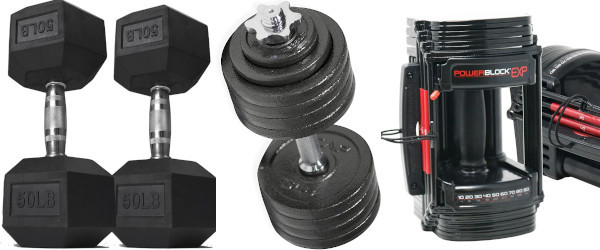
Dumbbell types left to right – fixed weight, loadable, adjustable
I’m not a fan of fixed weight dumbbells for a home gym because they require the most space to store. They can also potentially incur the most cost, since you have to buy new weights to keep making progress.
Loadable or adjustable dumbbells are much more versatile, although their initial cost will be higher than a single pair of fixed weights.
However, that one time cost covers a wide range of weight which could end up saving you money over multiple fixed weight purchases.
Here are some recommendations for each type of dumbbell:
- Rep Fitness Rubber Coated Hex Dumbbell Pairs – simple fixed weight rubber hex dumbbells
- Titan Fitness Rubber Coated Hex Dumbbells – another option for fixed weight rubber hex dumbbells
- CAP Barbell 60-Pound Adjustable Dumbbell Weight Set – despite the name these are actually loadable dumbbells
- Rep Fitness Adjustable Dumbbells – again, despite the name these are actually loadable dumbbells
- Rogue Fitness Powerblock Series EXP Dumbbells – true adjustable dumbbells that use a pin to select weight
- Bowflex SelectTech Adjustable Weights – true adjustable dumbbells that use a dial to select weight
Barbells
Barbell exercises are by far the most superior option for improving overall strength, size, and general fitness. Nothing else comes close.
If you have the space and budget for a barbell and bumper plates, then these pieces should form the cornerstone of your basic home gym.
You don’t even need a rack and bench to get the most out of your barbell. Here are just a few of the exercises you can do with only a bar and bumper plates:
- Power Cleans
- Front Squats
- Push Press
- Overhead Press
- Olympic Snatch
- Olympic Clean
- Olympic Jerk
- Lunges
- Deadlifts
- Bent-Over Rows
- Bicep Curls
- Hip Thrusts
- Overhead Squat
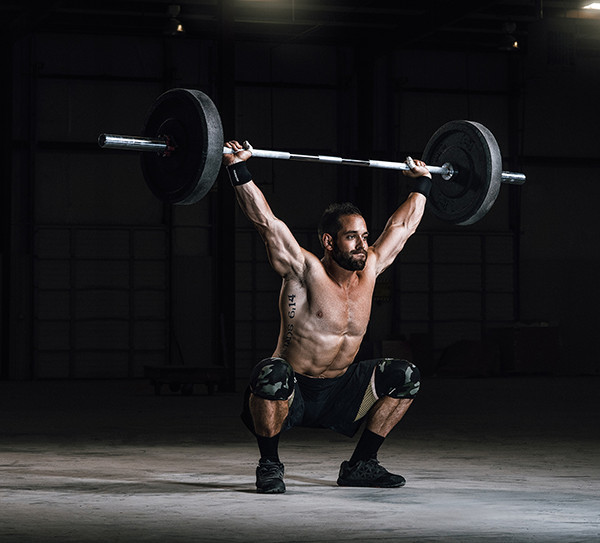
The overhead squat
Throw in some pull ups and push ups and you can work nearly every muscle in your body with this setup.
If you’re unfamiliar with what to look for in a barbell, I’ve written a Barbell Buying Guide that explains everything you need to know before making your first barbell purchase.
Here are my top barbell recommendations:
- American Barbell Cerakote California Bar (full review) – my top all around barbell recommendation for most people
- Vulcan Strength Training Systems Absolute Powerlifting Bar (full review) – a great bar if you want to focus strictly on Powerlifting
- Rogue Cerakote Chan Bar – the Chan bar offers many unique features suited for CrossFit and functional fitness training
If your space is tight and can’t accommodate a full size barbell, there are some great options for “shorty” bars as well.
Check out my short bar roundup, where I compare the best compact barbells I’ve been able to find.
Here are my top picks for shorty bars:
- Rogue C-70S Bar (full review) – best overall compact barbell
- Fringe Sport Shorty Barbell (full review) – best 28mm compact barbell
- American Barbel 10KG Performance Training Bar (full review) – best 25mm compact barbell
Don’t forget barbell collars, I have a set of inexpensive Lock-Jaw quick-release compression collars and they’ve served me well for many years.
Bumper Plates
I prefer bumper plates over steel plates for a home gym because there’s less risk of damaging your floors if you accidentally (or intentionally ?) drop a weight.
Along with a good barbell, a set of bumper plates is one of the best investments you can make to improve your strength, size, and overall fitness level.
I’ve written a Bumper Plate Buying Guide that explains everything you need to know to before making your first bumper plate purchase.
Here are my top bumper plate recommendations:
- Vulcan Strength Training Systems Black Bumper Plates (full review) – well made basic bumper plates
- Vulcan Strength Training Systems Alpha Bumper Plates – one of the very few options that can be dropped directly on concrete
- Rep Fitness Competition Bumper Plates (full review) – great competition bumper plates at a great price
- Titan Fitness Urethane Bumper Plates (full review) – urethane has no odor, which makes them perfect for an indoor home gym
Squat Rack / Squat Stands
You’ll need a rack or a pair of stands if you want to do barbell back squats or bench press. However, there’s no need to drop a lot of money on a big complicated power rack.
I used a pair of basic inexpensive squat stands from Valor Fitness for several years and they served me well.
It’s also possible to get a good squat rack at a decent price, and some of them include a pull up bar as well.
If you’re short on space, there are options for folding racks that can be stored out of the way when not in use.
Here are my top recommendations for stands and racks:
- Valor Fitness BD-9 Squat Stands – simple squat stands that I used for many years with no issues
- Fringe Sport Garage Series Squat Rack (full review) – great squat rack with a pull up bar that can be used with 8′ ceilings
- REP PR-1000 Home Gym Power Rack – a full size power rack that won’t bust your budget
- Rogue RML-3W Fold Back Wall Mount Rack – one of the best folding rack options available
Bench
A sturdy bench has a lot of uses regardless of whether or not you own a rack or squat stands. I own a basic flat bench, although having an adjustable bench increases the range of exercises you can do with it.
Here are my top recommendations for a bench:
- Rep Fitness FB-3000 Flat Bench – sturdy and cost effective basic flat bench
- Rogue Fold Up Utility Bench – great option if you’re tight on storage space, this bench can be folded up and stored on wall mounted hooks
- Rep Fitness AB-3100 Adjustable Bench V3 – the best value adjustable weight bench available right now
- Rep Fitness AB-5000 Zero Gap Adjustable Bench – the Cadillac of adjustable benches, it’s pricey but you won’t find a better bench
Flooring
Depending on where you plan to exercise, you may want to consider putting down some protective flooring. If your budget’s tight, horse stall mats from Tractor Supply can be used as basic gym flooring.
However, these mats are made from recycled tires and they have a strong rubber odor, so they’re not ideal if your home gym is inside your home rather than in your garage.
If your gym will be inside your home and if you’ve got some money to spare for protective flooring, here are a few options to consider:
- Minimal floor protection – interlocking foam tiles
- Medium floor protection – 3/8” thick 4′ x 6′ Hi-Color Rubber Rolls
- Maximum floor protection – 3/4” thick 4’ x 6’ Rubber Shock Mats
I’m using a Shock Mat with blue color flecks on my DIY lifting platform and my only regret is that I didn’t buy one sooner.
The unique waffle pattern on the underside of the mat deadens even the hardest impact and the color options add some really nice flair.
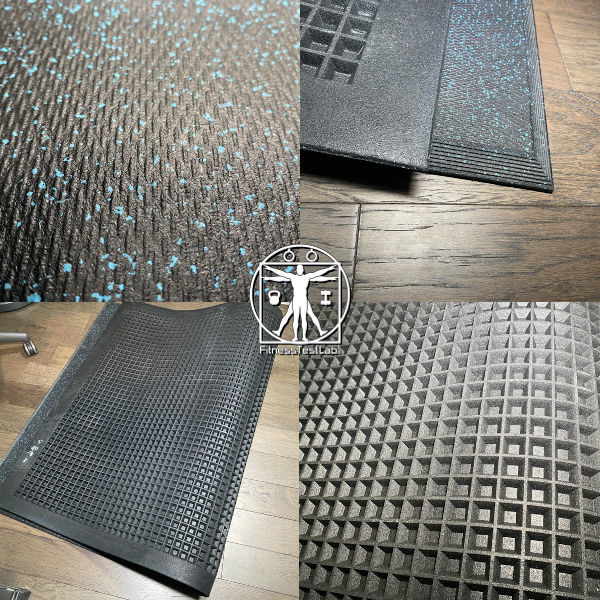
Shock Mat from Rubber Flooring Inc
Cardio
Exercising with free weights and kettlebells is awesome, but if you really want to burn off calories you’ll need some cardio in the form of high intensity interval training (HIIT).
Don’t worry though, no need to spend a lot of money on a machine when a simple speed rope is cheap and efficient.
However, if jumping up and down repeatedly isn’t your thing then there are other options.
Here are some basic low cost ways to get your cardio on:
- Speed rope – modern take on the old-as-dirt jump rope. Light, fast, and easy to store.
- Inertia Wave (full review) – a more efficient variation on battle ropes that will work your entire body. Discount available with code ‘TESTLAB10’ ?
- Running – all you need is a good pair of shoes!
- Swimming – not really low cost, but great if you have access to a pool ?♂️
If you’re interested in machines and you have the space and cash for one, I’ve got you covered.
Here’s what I like and recommend:
- Assault Fitness AirRunner (full review) – a curved motorless treadmill built like a tank
- VersaClimber (full review) – low-impact climbing machine that targets all the major muscle groups
- AirDyne Pro – one of the best air bikes on the market. I own one that I’ve not yet reviewed but I like it a lot
- Rogue Echo Bike – another great air bike, and one of the most affordable
- Xebex Rower 2.0 – a lower cost rowing alternative to the Concept2, with the added benefit of folding in half for ease of storage
Other useful gear
This section covers equipment that doesn’t fit into any other category but is still useful to have.
- Ab wheel – old-school core strengthener. Don’t spend more than 20 bucks on one, they all work the same way
- Weight vest – simple way to kick any workout up a notch. I did a weight vest comparison review, you should check it out.
- Sandbags – shifting sand will seriously challenge your stabilizer muscles as you try to heave the bag around
- Resistance bands – so many ways to use resistance bands. They don’t take up much space and they are relatively cheap
- Pull up bar – Pull ups are one of the best back strengthening exercises you can do. A door mount pull up bar is great for pull ups in tight spaces
- Gymnastic rings – way better than a pull up bar if you have a place to mount them. See my article on how to mount them from your ceiling.
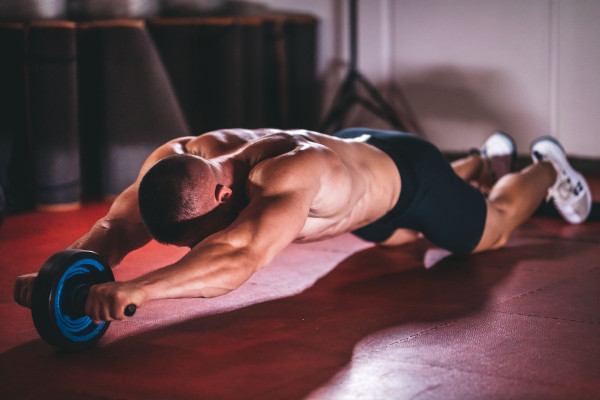
The ab wheel is simple and effective for strengthening your core
Conclusion
As I wrote at the beginning, you don’t need a room full of expensive equipment to achieve your fitness goals.
My aim with this article is to give you the information you need to build a basic home gym that meets your specific needs, space constraints, and budget.
I’ve outlined several categories of equipment I think are best suited for a basic home gym, including recommendations for each category and some upgrade options for those with extra funds.
Armed with this information, you should be able to build a home gym that suits you.
If you have any questions that I did not cover, please leave a comment and I’ll do my best to answer you.
About the Author Mario
I'm a software product manager with a full-time job, family, and a desire to stay strong, mobile, and fit. I separate fact from fiction to find the most effective and affordable options for home fitness. If you'd like to build your own home gym, start here.
Popular posts
Session expired
Please log in again. The login page will open in a new tab. After logging in you can close it and return to this page.

